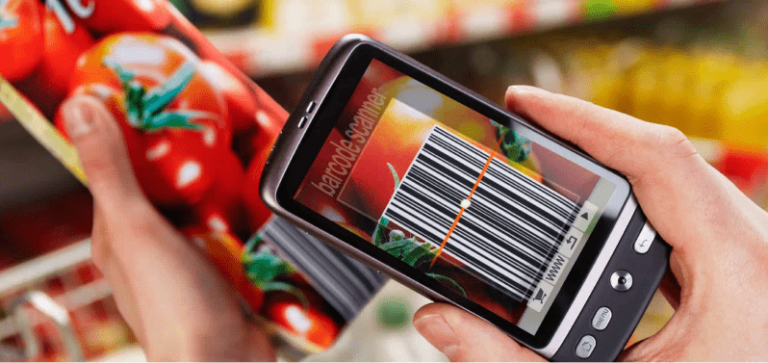Modern technology has been paving the way towards entirely digital workflows throughout the past decade. Nowadays, a wide variety of use cases can be covered using intelligent mobile devices, creating streamlined digital workflows that are cost-efficient, easy-to-use, and coherent. Those changes towards smartphone-based business processes did not just affect the productivity of singular workflows but also onboarding processes. Especially when facing high personnel fluctuation, companies need to keep onboarding efficient and quick. The majority of potential employees are familiar with smartphone usage and have a basic understanding of digital workflows and interfaces. Leveraging this, companies can drastically reduce the time spent on training and increase efficiency, as there is no need to teach new employees how to use unfamiliar hardware devices first.
Especially around barcode scanning, low-budget smartphones can replace dedicated handheld scanners when combined with the right software solution. This is particularly advantageous for two-dimensional barcodes, as these can only be read with camera-based devices. Yet, countless companies are still relying on industrial barcode scanners instead of enabling barcode scanning on smart devices, which allow the same high-quality results, robustness, and data privacy at a much lower cost due to less maintenance and acquisition expenditures.
Dedicated scanners vs. smartphones – 6 decision-making factors
Let’s outline the most crucial decision-making factors when switching from dedicated hardware scanning devices to smartphones with integrated barcode scanning software and clarify some misconceptions revolving around smartphone usage for professional scanning purposes.
- Scan performance: Smartphones are designed for consumers. And since they see the camera as the main differentiator when buying a smartphone, manufacturers have evolved the camera systems to pro-standards with sharp lenses and high-resolution sensors that work perfectly in low lighting conditions. Accurate scanning results, which are ready for further processing, can be achieved and transmitted within mere seconds by means of modern smartphone technology.
- Battery: When considering smartphones for barcode scanning tasks, battery life becomes an essential factor. Employees need to use the devices wirelessly, on the road, or in their workspace. Modern budget smartphones below $200 contain batteries that can store around 5000 mAh to last a whole day. Comparable dedicated scanning devices operate within a range of > 4150 mAh while being priced way above $1000 a piece.
- Cost of acquisition and maintenance: Apart from the initial expenses of standard smartphones, which can be up to 5x cheaper than for high-class scanning devices, the maintenance of those devices is way more effortless. One report from Statista highlights that the average lifespan of a smartphone is expected to be around 34 months in 2020, making mobile devices a suitable solution for long-term use.
- Convenience of use: As stated priorly, smartphone workflows are often handled intuitively by a broad range of users due to their familiarity with mobile devices and different user interfaces. l For a comfortable smartphone-based process, large screens that display information in an effortlessly readable manner are essential. According to Statista, the average screen size of a smartphone varies between 5″ and 6″. This allows comfortable usage for various purposes. Budget handheld scanners often do not even have a display indicator, which means that it is impossible to immediately check whether the scanning process has been carried out correctly.
- Robustness: Display protection sheets and highly protective smartphone covers ensure robustness for all standard mobile devices. Today’s smartphones are often IP 65 certified and are safe from dust and splashes of water.
- Data privacy: Handling highly sensitive data on a smartphone is not a problem if the app is protected. Enterprise apps can use fingerprint- or face recognition features of smartphones to securely lock the app or the whole device. Furthermore, components like the Scanbot SDK can store data fully encrypted, so that it is never accessible.
The Scanbot Web Barcode Scanner SDK makes use of so-called “On-device-intelligence” and thus processes data exclusively on the end user’s device, leading to compatibility with standards such as GDPR, CCPA, and more.
Device convergence – The concept of the future
Converged devices have been an essential topic in the technology sector for more than a decade now. The act of sharing the same resources for synergized functions was supposed to build the foundation for intelligent devices that can cover a vast variety of different purposes, such as tablets providing a fusion of smartphones and personal computers.
Talking about converged devices in business, smartphones are steadily turning into multi-purpose tools that allow the enclosure of several functionalities for both customers and employees. This does not just apply to barcode scanning, with smartphones being able to replace traditional hardware document scanners, NFC readers, or OCR processing all at once.
Turning a mobile device into a multi-tool with the Scanbot SDK
Integrating a Barcode Scanner into any workflow without depending on a dedicated in-house app becomes a reality with the Scanbot Web Barcode Scanner. If preferred, mobile app-based workflows can be built using the standard Barcode Scanner, which offers an even larger amount of cutting-edge features.
Want to see our Web SDK for Barcodes or the In-App Barcode Scanner in action? Test the integration into your existing workflow with our free trial license or contact us for a free demo call. Let’s talk.







